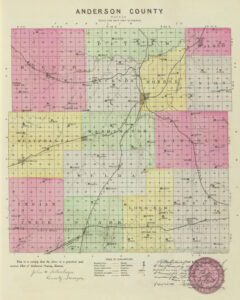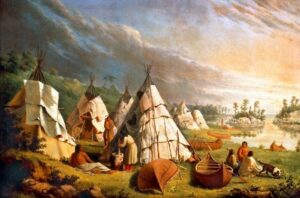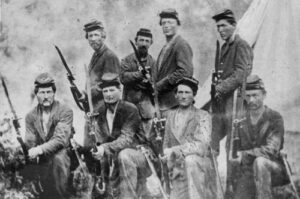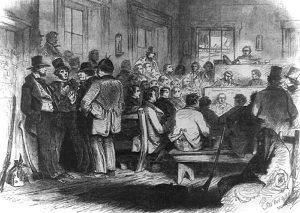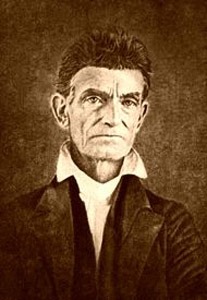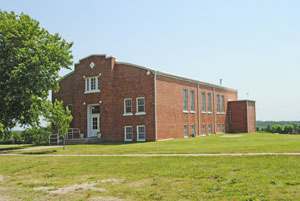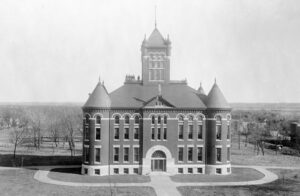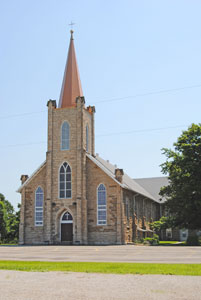Towns & Places:
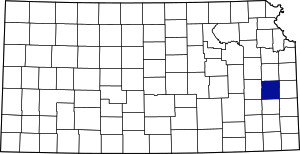
Anderson County, Kansas Location.
Garnett – County Seat
Greeley
Kincaid
Welda
Westphalia
Extinct Towns of Anderson County
Cedar Valley Reservoir
North Lake Park
In East Central Kansas, Anderson County was established in 1855 while Kansas was still a territory. It was one of the 33 original counties established and was named for the pro-slavery speaker pro tem of the territorial legislature, Joseph C. Anderson. The county comprises 24 square miles, and Garnett is the county seat.
Years before Kansas was a territory, the U.S. Government moved native peoples from different tribes in the East to a permanent Indian frontier in Kansas. In September 1838, 859 Potawatomi Indians were forced from their homeland near Plymouth, Indiana, and marched 660 miles to present-day Osawatomie, Kansas.
Called the Potawatomi Trail of Death, the tribe was escorted by militia along the 660-mile journey. During the two-month journey, 42 members of the tribe, mostly children, died of typhoid fever and the stress of the forced removal, and about as many had escaped along the journey. When they arrived in Osawatomie, Kansas, that November, only 756 tribe members were left. Their principal village was just across the northern boundary in Franklin County, at a place known as Dutch Henry’s Crossing on the Pottawatomie River. The Potawatomi tribe was reassigned to present-day Pottawatomie County between 1847 and 1848.
When the first white settlers came to Anderson County in May 1854, they found some of the fields the Indians had cultivated. They were Valentine Gerth and Francis Meyer, who came from Missouri and settled on the Pottawatomie River near the present site of Greeley. These men, without families, planted and cultivated the old Indian fields the first summer. Henry Harmon came with his family and settled near the junction of the branches of the Pottawatomie. More settlers came during the summer and fall: Henderson Rice, W. D. West, Thomas Totton, Anderson Cassel, J. S. Waitman, and Dr. Rufus Gilpatrick. Several Germans came to the county in the winter of 1854-1855. They settled along the south branch of the Pottawatomie River above Greeley, where they built several cabins and selected valuable timber claims. In the spring of 1855, they returned to St. Louis, Missouri, and, on account of the territorial troubles, never came back. Other settlers soon took up their claims.
On November 8, 1854, Governor Horatio Reeder issued a proclamation ordering an election on November 29, when Anderson County could be made a part of the Fifth District. The election was held at Henry Sherman’s house near Dutch Henry’s Crossing on the Pottawatomie River. At the election for the first territorial legislature members, A. M. Coffey and David Lykins were elected to the council, and Allen Wilkerson and H.W. Yonger were made representatives. Of the resident voters, including about 50 men who were primarily Free-State advocates, only a few voted. However, many Missourians crossed the state line and cast about 200 pro-slavery votes.
After the legislature defined the county’s boundaries, it provided for its organization and the election of county officers. In a joint session, the legislature elected George Wilson as probate judge and commissioned him for two years on August 27, 1855. Wilson was the first commissioned officer and, immediately after qualifying, set out for the county. On September 10, he arrived at Henry Sherman’s house, where he remained until September 15, when he went to the house of Francis Meyer near the present site of Greeley. Judge Wilson had designated Meyer’s house as the temporary seat of justice and notified William R. True and John C. Clark, appointed county commissioners, and A.V. Cummings, appointed sheriff, to meet him there on September 15 to complete the county organization. However, all three refused to accept the appointments. Cummings was a resident of Bourbon County.
The survey of the public lands in Anderson County began in the fall of 1855. Some of the first settlers who came to the county were of the class who made a living speculating in government land claims. They selected the finest timber and valley lands along the streams and, after settling, staked out other claims under fictitious names, then offered to sell those claims to new arrivals. The buyer of such claims would often go back East to return with his family and, upon his return, find his cabin occupied, so the speculator sold the claim a second time. These claims caused much trouble in the United States Land Office.
The early years of Anderson County, located near the Missouri border, where pro-slavery sympathizers lived, were impacted by violence. The political climate that earned the title of Bleeding Kansas brought a cycle of revenge and retaliation that resulted in the destruction of property, loss of lives, and increased tensions on both sides of the Kansas slavery issue. Because of the outrages committed against the Free-State settlers, a military organization of Franklin and Anderson County men, the Pottawatomie Rifles, was formed in the fall of 1855. The members were Dr. Rufus Gilpatrick, M. Kilbourn, W. Ayers, H. H. Williams, August Bondi, Samuel Mack, James Townsley, and Jacob Benjamin from Anderson County.
In October 1855, free-state voters polled 49 votes at the Pottawatomie precinct to elect delegates to the Topeka Constitutional Convention. However, only 14 people from Anderson County voted for the adoption or rejection.
At the October 1855 election for a delegate to Congress, George Wilson was the only candidate in the district. Samuel Mack, one of the judges, refused to vote, regarding the election as a farce. However, voters arrived, most of whom were from Missouri and came over on horseback and in wagons, well supplied with whiskey and guns.
Wilson then appealed to the governor for assistance in organizing the county, and Acting Governor Wilson Shannon commissioned Francis Meyer, F.P. Brown, and Henderson Rice as commissioners and sheriff, respectively. Still, Brown and Rice would not accept the commissions. George Wilson and Francis Meyer organized the county on January 7, 1856. Five days later, the second session of the probate judge and commissioners’ court was held at Meyer’s house, and David McCammon was appointed sheriff. He gave bond and qualified on January 18, when the court held its third session, and J. S. Waitman was appointed commissioner. This was the first time that a full board of commissioners had existed. At this time, C.H. Price was appointed justice of the peace for the county and commissioned by Judge Wilson. Price qualified on March 5, 1856, and on the same day, was appointed county treasurer. On February 4, 1856, Thomas Totton was appointed county clerk. On March 9, a petition for the location of a road from Henry Sherman’s house to Cofachique, the county seat of Allen County, was considered. David McCammon, James Townsley, and Samuel Mack were appointed commissioners to open the road, which was to be 70 feet wide. This was the first road in the county.
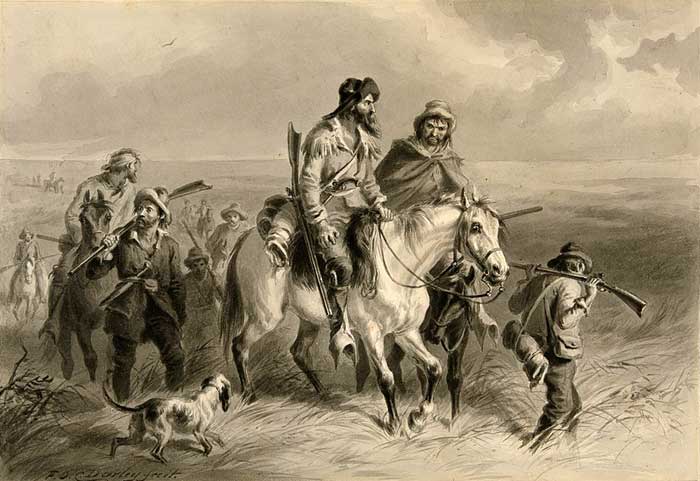
Border Ruffians in Kansas by F.O.C. Darley.
On February 18, 1856, a petition was presented to the commissioners, signed by A. McConnell and 15 others, requesting a permanent location of the county seat, and David McCammon, James Townsley, and Thomas Totton were appointed to select the site, provided it should be located within three miles of the geographical center of the county. The commissioners selected Cedar Bluff (Later Shannon), where the county business was transacted until April 5, 1859. The first term of the district court was held on the fourth Monday in April 1856, with Sterling Cato, one of the territorial judges, presiding.
In 1856, pro-slavery men invaded the county regularly, intimidating free-staters and damaging their property, sometimes driving them away. Radical abolitionist John Brown and his followers murdered several pro-slavery men in retaliation during the Pottawatomie Massacre on May 24, 1856, in nearby Franklin County.
Dr. Rufas Gilpatrick saw pro-slavery forces burning houses near Greeley. After sending an alert, Captain Steward, Captain Samuel Anderson, his Pottawatomie Guards, and Captain Cline attacked the invaders. They were caught unaware and retreated to Missouri, where they incorrectly reported that 10,000 men, rather than 100 men, had attacked them. Brown had been with the free-state forces but left to pursue “ruffian” forces reportedly near Greeley, but later rejoined them.
During the summer months of 1856, free-staters felt unsafe at home at night and would gather their families, with the men standing guard. They relied on supplies from Kansas City that had to pass through pro-slavery guards. Some members of the Pottawatomie Rifles, organized by John Brown, Jr., were from Anderson County.
About this time, a party of some 200 Missourians camped on Middle Creek at Battle Mound, waiting for reinforcements preparatory to a general movement against the Free-state settlements along the Pottawatomie River, and many outrages were committed in Anderson, Linn, and Franklin Counties. Among these was the capture of George Partridge on August 27, 1856, and on the same day, the burning of the houses of Kilbourne and Cochrane near Greeley. Dr. Gilpatrick, while making calls, discovered the pro-slavery camp and immediately issued a warning. The Pottawatomie Rifles, under the command of Dr. Gilpatrick, made an attack early in the morning of August 28, which was a complete surprise, and the pro-slavery men retreated in great confusion to Missouri. Another detachment of pro-slavery men robbed Zach Schutte and attempted other atrocities, but upon hearing of the capture of the camp, they also hastily fled into Missouri.
During the summer and fall of 1856, Anderson County was overrun by bands of lawless pro-slavery men known as “Border Ruffians.” The officers of Anderson County had been chosen because of their loyalty to upholding slavery.
When the border difficulties culminated in 1856, Anderson County officers actively participated with the pro-slavery men. The Free-State men refused to countenance such conduct on the part of the officers, and late in the spring, Francis Meyer, John S. Waitman, David McCammon, and George Wilson, having been concerned in several pro-slavery atrocities, were forced to flee from the county. No county business took place between May 1856 and January 1857, with heightened tensions from the violence.
There was continued trouble along the Pottawatomie River until the government ordered United States troops to the neighborhood. They camped for several weeks a short distance from the present site of Greeley, but were commanded by pro-slavery officers who afforded little protection to the free-state settlers. The Pottawatomie Rifles were drilled at the farm of W. L. Frankenburger and participated in many of the expeditions of 1856-57. During the fall of 1856, pro-slavery invasions became so frequent that it was unsafe for the settlers to remain at home overnight with their families. They would collect at Frankenburger’s claim on the Pottawatomie River for several months. The women and children took shelter in the cabin while the men remained on guard. Anderson County men, commanded by Dr. Rufus Gilpatrick, took part in the Battle of Osawatomie under John Brown. When Governor Daniel Woodson declared the territory in a state of insurrection and rebellion and called out the militia, several settlers left Anderson County and never returned.
Dr. Preston Bowen surveyed Cedar Bluff in 1857, and construction of county buildings began.
In November 1858, a free-state squatters’ court was organized in Anderson, Linn, and Bourbon Counties to adjust land claims. Dr. Rufus Gilpatrick was elected judge. The court’s decisions were generally satisfactory to the settlers and enforced by Major Abbott and a minister named Stewart, known as the fighting preacher.
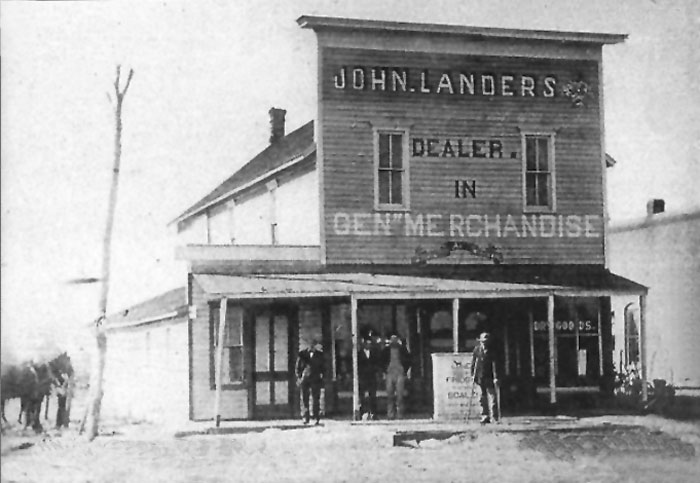
Hyatt, Kansas Store.
Several townsites were then laid out, but with two exceptions, the towns failed to become important. Garnett and Greeley were both surveyed in 1856 and have since become flourishing communities. In December 1856, a party of 80 men was formed in Lawrence, Kansas, to settle in Anderson County. A townsite was selected in the northern part of Washington Township, and the town was named Hyatt. The founders proposed making it the county seat. A sawmill was built in the spring of 1857. In the fall, a grist mill was added, and B.F. Allen opened a store. A post office and a school were established, but the dream of establishing a county seat was not realized. Soon after the county seat was permanently located at Garnett, Hyatt was abandoned.
Cattle drives from Texas passed through the area beginning in 1857 and brought a disease called Spanish fever, which killed native cattle. The drives ceased during the Civil War (1861-1865) and resumed in 1866, bringing more disease.
The first mail route in Anderson County was established on January 11, 1858, to run from Leavenworth to Humboldt in Allen County via Hyatt. The route was marked, and service began in March. There was a road from Carlyle and one from Fairview to Hyatt. Zach Squires was the first mail carrier and expressman. At first, the post was weekly but soon changed to a tri-weekly service. In the spring of 1859, the route was changed to run through Garnett, where a post office was established. In the fall of 1859, the county board received petitions to open five roads, and the old maps show that they all centered on Hyatt, none on Garnett or Shannon.
On November 30, 1857, the county commissioners signed a contract to construct a courthouse and jail at Shannon. Dr. Preston Bowen was to build it for $1,000, but at the election held on January 26, 1858, it was shown that most people opposed the erection of the buildings. The commissioners, therefore, resigned. On February 12, 1858, the legislature changed the county organization from a board of commissioners to a board of supervisors. On June 14, the new board contracted with Dr. Bowen for a courthouse and jail at Shannon’s own expense, to be completed within a year.
Many early settlers of Anderson County were Catholics, and the St. Boniface Catholic church in Putnam Township was the first church building erected in 1858.
Education was one of the first considerations of the early settlers. The first school district laid out was near Scipio in Putnam Township, and the first superintendent of public instruction was John R. Slentz, appointed by the governor near the close of 1858.
The jail was completed at Shannon, and work began on the courthouse when, in the spring of 1859, the county seat was located at Garnett by an act of the legislature, and the first meeting of the board of supervisors at Garnett was held on April 5, of that year. After the county seat was moved, the Shannon townsite was soon abandoned.
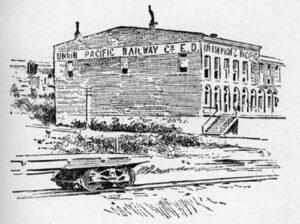
The Wyandotte Constitution meetings were held in the Union Pacific Railway building in Kansas City, Kansas.
In March 1859, an election was held on the proposition of a state constitutional convention, and of the 185 votes cast in Anderson County, the majority were against holding the convention. On the first Tuesday in June 1859, an election was held for a delegate to the convention. Dr. James G. Mount and W. F. M. Arny were the candidates from the Anderson County district. Blount was elected and sat in the Wyandotte Convention.
The United Brethren built the first Protestant church in Garnett in 1859.
The outbreak of the Civil War in April 1861 caused great excitement in Anderson County. At the call for volunteers, an entire company enlisted in one day. Anderson County was represented in nearly every Kansas regiment, with about three-fourths of the able-bodied men entering the Union Army. In 1861, the county’s population was a little over 1,000.
The first county building erected in Garnett was the jail, built in 1864. In 1868, the courthouse was erected on Oak Street in Garnett.
The first newspaper in the county was the Garnett Pathfinder, which I. F. Olney established in January 1865. It was the only publication until 1868, when W.H. Johnson started the Garnett Courant.
In 1871, while under the charge of Father Albert Heinemann, the St. Boniface Catholic church in Scipio erected the Mount Carmel college building about six miles north of Garnett.
A county fair was held in Anderson County as early as 1863, but the county fair association was not organized until November 15, 1873. It was capitalized for $5,000.
The survey of the public lands in Anderson County closed in the spring of 1886.
In 1891, the legislature passed an act providing for the erection of a courthouse on the county square in Garnet at a cost not to exceed $40,000.
A new three-story Romanesque-style courthouse was built in 1901 and 1902. It features a bell tower, a hip roof, and semicircular corner towers. A statue of the Roman goddess Justina stands over the west entrance of the roof. In 1972, the building was listed on the National Register of Historic Places.
In 1910, Garnett, the county seat, was the largest town and railroad center. Colony, Greeley, Harris, Kincaid, Lone Elm, Selma, and Welda were other important towns and villages. The county’s population was 13,829. According to the State Board of Agriculture report, the total value of farm products for that year was $1,437,654.37.
At that time, lime and sandstone were plentiful, while red ocher was found in Reeder Township. Coal had been found in several places, including natural gas wells near Greeley. Corn, wheat, oats, and Kafir corn were the leading agricultural products. Livestock raising was a productive industry, and the county had more than 100,000 bearing fruit trees. The county also had more than 130 miles of main railroad tracks. The Missouri Pacific Railroad had three lines — one crossing the county diagonally from the northwest to southeast, passing through Garnett; a second entered the county in the northeast and crossed the western border near the center, and the third crossed the southern part almost directly east and west. The Atchison, Topeka & Santa Fe Railroad ran north and south near the center, and a branch diverging from Colony in the southwest crossed the southwest corner. The Missouri, Kansas & Texas Railway also crossed the southeast corner.
The Civilian Conservation Corps began constructing Lake Garnett on October 15, 1934. The project, which included a dam, spillway, two shelter houses, a football stadium, a swimming pool, and landscaping on 48 acres, was completed in 1936.
Grand Prix racing was established in 1959 with the Sports Car Club of America. Racing proved so popular that it tested the community’s resources. In 1963, hundreds of partiers turned violent and forced the races to be canceled. Supporters revived the races in 1968, and that tradition continues today. A 320-acre lake and reservoir were constructed on the site in 1985.
The county’s population was 7,836 as of the 2020 census. Garnett is the county seat and the most populous city.
©Kathy Alexander/Legends of Kansas, updated December 2025.
Also See:
Kansas Counties
Kansas Destinations
Sources:
Blackmar, Frank W.; Kansas: A Cyclopedia of State History, Vol I; Standard Publishing Company, Chicago, IL 1912
Cutler, William G.; History of Kansas; A. T. Andreas, Chicago, IL, 1883.
Kansapedia
Kansas Post Office History
Kansas State Historical Society
Wikipedia


